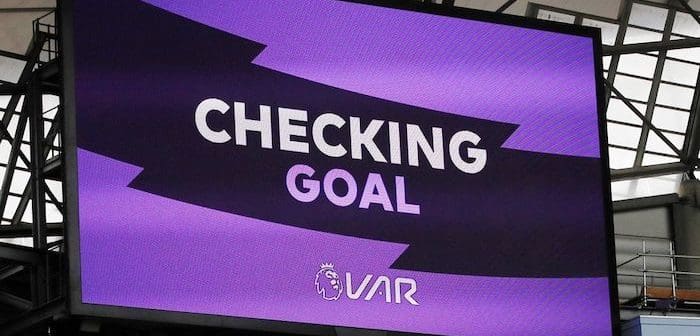The Premier League’s decision to introduce Video Assistant Referees is irreversible, but it’s almost unanimously acknowledged that the system requires improvement amid mounting criticism.
Even if it takes a decade to get it right and achieve complete acceptance, as with DRS in Cricket, it’s here to stay.
VAR was brought in to reduce clear and obvious errors, not to re-referee the game.
Even those who loath technological progress must admit the number of refereeing howlers is lower.
That’s true, despite the Premier League’s bar for what constitutes clear currently being set somewhere in the away end at St James’ Park – high.
Many supporters feel that the system is, sometimes, too correct though – specifically with close offside decisions.
But the Laws of the Game are clear: A player is either onside, or they are not.
There’s no grey area in the rules; ‘armpit offsides’ are a problem in all leagues that use VAR, not just the English top flight.

Raheem Sterling is caught millimetres offside in the build up to Gabriel Jesus’ disallowed goal at the Olympic Stadium in August (credit: BT Sport)
Current proposals
Ex-Arsenal manager Arsène Wenger, in his gravy-train position as FIFA’s Head of Global Development, has pushed ahead with proposals to trial changing the offside law.
It’s been mooted as introducing a day-light element to offside decisions, but actually goes much further.
His suggested law change is that, if any part of the body an attacking player can score a goal with is in line with a similar part of the last defender, then that player would be considered onside.
That means a pacy striker could essentially be a whole stride ahead of their marker, but because their trailing heel is in line with the defender’s chasing foot when the ball is played, they wouldn’t be flagged offside – even with clear daylight between their torsos.
Essentially, players would be allowed to be a yard ‘offside’.
Any such an amendment to the offside rule would, therefore, do nothing to reduce VAR controversies.
It would simply move, rather than solve, the problem around tight decisions, from the most advanced part of an attacker’s body poking out beyond the second rearmost defender, to their least advanced limb and the point at which a gap emerges.

Mason Mount was clearly stood offside before César Azpilicueta thought he’d equalised for Chelsea against Liverpool, but the goal would be allowed under Wenger’s proposal (credit: Sky Sports)
Other pundits, typically in the Match of the Day studio, have put forward the idea that if a decision is really close – for example, under ten centimetres – it shouldn’t be ruled offside.
How could defences train to keep a tight line though, knowing attackers are allowed to break their offside trap and still score legally?
Such an adjustment to the rules would also, again, simply shift the problematic, controversial calls back ten centimetres when the replays are paused.
There would be just as many marginal decisions at the boundaries of a margin of error; ‘they were only millimetres offside’ would simple become ‘they were only millimetres over (or under) the threshold’.
Alternative ideas
Football could take inspiration from cricket and introduce a formal grey area of human interpretation on the field, that favours an assistant referee’s original decision rather than the attacker or defender.

If a possible LBW wicket in cricket is borderline, the umpire’s original on-field decision stands (credit: ECB)
Whether the distance used was ten centimetres, a foot or half a yard, the benefit of the doubt in offside decisions that were under a certain measurement either way would rest with the live, naked-eye judgement.
In practice, this would mean that if a player scores and the flag stays down, VAR can only then rule the goal out if the scorer – or an influential player in the build-up – is shown on the replays to be offside by more than the distance.
This set-up would also mean that if an assistant referee signals for offside, if their decision is correct, even if only by a millimetre, it stands.
The attacker would, too, have to be onside by more than the determined measurement to get a decision overturned and originally disallowed goal awarded in their favour.
In short, if it’s very close either way, stick with the on-field decision. The snag? It could take more on-screen lines and even more time.

A linesman raises his flag for offside (credit: The Sun)
Another option would be to simply get the referee, or the assistant who made the initial call, to review a crucial offside decision if the VAR thinks it’s close.
They could use replays and freeze frames, on the pitch-side monitor, without diagrams that belong in a secondary school maths class.
A simple line would do, but even that is unnecessary. What happened to allowing elite officials to exercise their judgement?
Offside decisions have been determined by the naked eye of an official, since the law was introduced to football in the Victorian era.
If officials still can’t tell whether a player is offside or not after a couple of extra views and alternative angles, they’re not offside. End of.
Pitch-side monitors
There’s been plenty of criticism of the Premier League’s so-called high bar approach to subjective VAR decisions – penalties and red cards – too.
It should be remembered that VAR was not designed to be perfect and never can be, due to the human element.
It was introduced because, in rough terms, getting nine out of ten big decisions right with VAR, is better than only eight out of ten without it.
There will always be big decisions that, rightly or wrongly, pundits and fans, a majority of even, disagree with.
Consensus was that Jon Moss shouldn’t have awarded Manchester United a penalty at Villa Park recently, when Bruno Fernandes attempted a 360-degree spin on the edge of the box and was bumped into by a clumsy Ezri Konsa.
But, afforded the opportunity to review it on the pitch-side monitor, he would’ve almost certainly stuck with his original, correct decision.

Konsa sweeps into the spinning Fernandes and is correctly penalised (credit: AP)
The justifiable criticism of VAR in the Premier League has arisen from the fact that he and his colleagues aren’t given the chance to look again.
Those at Stockley Park are reluctant to overrule their mates’ on-field judgements, but are barred from recommending a review.
At the moment, there’s currently a no-man’s land where the VAR doesn’t want to flat-out say ‘you definitely got it wrong’, but can’t ask the referee to take a look at the screen either – so some pretty clear decisions are getting missed.
In other major leagues, the VAR constantly reviews the match and tells the on-field referee if there’s anything he worth taking another look at on the monitor.
But the Premier League process, until they fall in line next season, is currently to have the referee describe what he’s seen to the VAR.
Unless what is shown on the replays definitively does not match what’s described, there’s no overturn. Put simply, the protocol is daft.
There is some merit to removing the public perception that a decision ‘wasn’t even reviewed’ or ‘looked at properly’, as well as giving the referee a genuine chance to consider their verdict for both potential penalties and sendings off.

Referee Chris Kavanagh was not even allowed to take another look at this Romeu challenge (credit: Sky Sports)
Premier League referees have, since Christmas, started to take a token glance on the most obvious of red card overturns.
But this has been a mere confirmatory process, when TV viewers have already seen half a dozen angles and the VAR has already decided the offence should result in a sending off.
Fortunately, the IFAB have done something about this for next season, by emphasising the expectation that a subjective reviewable incident should be looked at by the on-field official.
That means any potential penalty or sending off, much like everyone got used to at the 2018 World Cup.
The VAR in each game will still have to decide what is ‘reviewable’, but it’s a lot easier to say ‘this incident is worth a look at least’ to their mate in the middle, than making the decision for them as the Premier League currently expect.

Michael Oliver make a rare trip to the pitch-side monitor as Luka Milivojević is sent off in Crystal Palace’s FA Cup defeat to Derby (credit: Sky Sports)
Next season will also see the VAR clamp-down on encroachment from goalkeepers if they save penalties, with the option for leniency that the Premier League currently employs set to be stamped out.
Officials will also be stricter on outfield players sneaking into the box before spot-kicks are taken – though this is now judged on feet position, not just leaning over the 18-yard line.
Handball decisions
The Laws of the Game have been updated for the 2020-21 season, to get rid of ridiculous handball decisions off the shoulder.
For determining handball offences, the rules now state that the arm ‘stops at the bottom of the armpit’ – so biceps can still be penalised, but shoulders can’t.

The new handball law for next season (credit: IFAB)
Fans of the English top flight could see more penalties awarded for handball next season though, since FIFA took control of VAR from the IFAB last week.
Pierluigi Collina, who is the chairman of the global governing body’s referees committee, is set to ensure the system is applied consistently across all leagues that use it.
Notions such as ‘that’s handball at international level,’ ‘that would be a penalty in the Champions League,’ or ‘they would be sent off if this was in Italy’ are about to come to an end – they should now be given in the Premier League too.
Communication could continue to be an issue though, as there are currently no plans to allow fans to listen in on conversations between officials reviewing a decision via the VAR system, as other sports do.
Supporters in stadiums could easily be shown the same replays that TV viewers see when a decision is being considered though, instead of the text that’s currently displayed.

Stuart Attwell in secretive communication with the Video Assistant Referee (credit: Ian Kington)
The idea of a time limit on VAR decisions won’t ever get off the ground either, because it would mean rushed judgements and potentially not allow TV directors to find the most conclusive angle.
Pundits and fans alike who think it often takes too long would do well to remember that a major factor in VAR’s introduction was the ridiculous over-analysis of decisions during televised matches.
Speed may improve a little as officials gain experience each season, but it’s ultimately better to be slow than incorrect.
The biggest waste of time in football at the moment is people calling for VAR to be scrapped.
It’s here to stay; you can’t close Pandora’s box. Everyone needs to learn to live with it and find solutions. Just not Mr. Wenger’s.
Follow us on Twitter @ProstInt
![Prost International [PINT]](https://prostinternational.com/wp-content/uploads/2021/08/PINTtFontLogoRoboto1536x78.jpg)



